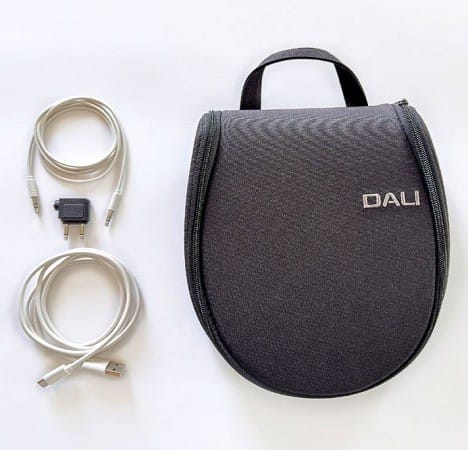DALI IO-8 Wireless Noise Cancelling Headphones Review
Speaker manufacturer DALI has also found success with headphones. The brand-new IO-8 closely resembles the top model IO-12 but is more affordable.
Downsizing has become a popular term in the last decade when products are reduced in performance or price. Unfortunately, this often results in a bigger quality loss than the price savings, which usually becomes obvious after purchase and often leads to frustration or at least dissatisfaction.
At DALI, they wanted to avoid this trap and ensure their customers didn’t fall into it either. That’s why it took some time for the team in Denmark to find a way to bring the quality of the IO-8 headphones, tested here, close to the top model IO-12 while reducing the price to a level that causes far less financial stress for many interested buyers.
Technically, a lot has been borrowed from the IO-12. The driver, with its 50-millimeter diameter and ultra-thin paper fiber diaphragm, is largely identical in design. The only thing missing is DALI’s patented SMC technology. The magnetically conductive SMC granulate has very low electrical conductivity, allowing the voice coil to move more precisely and quickly.

Electronics from the IO-12
The electronics, including the Qualcomm aptX chip for optimal Bluetooth transmission with up to 24-bit/96 kHz quality and the Sony ANC chipset, which preserves the sound almost unchanged with noise cancellation activated, have been fully adopted.
The combination of passive filters and an amplifier unit with a Class D output stage already proved its quality in the IO-12. The ANC works effectively, and the two-stage sound adjustment—either neutral or bass-boosted—is controlled directly on the headphones, not through an app.
The same applies to the volume control, which is adjusted with light pressure on the edge of the red-marked right ear cup. This marking is printed on the inside of the headband.
When you remove the headphones, the music pauses. Customers will also appreciate the build quality, featuring real leather on the headband and ear cushions, along with the sturdy design of the headband. The ear cushions are shaped differently and slightly smaller than those of the IO-12, but they can be easily replaced. Battery life is about 35 hours without ANC and 30 hours with ANC, making it suitable for long trips with music. Charging takes just under two hours.

Comfort, especially for those wearing glasses, is slightly less than with the bigger brother, which fits almost weightlessly. However, with a relatively light weight of 325 grams, the IO-8 is still suitable for extended wear. It doesn’t matter whether you use it wirelessly or with a cable, although using the analog cable disables the calling feature.
The wireless connection is quick to establish and remains stable even over larger distances, up to about 10 meters in enclosed spaces.
Powerful Bass, Delicate Highs
The sound profile is built on a clean and powerful bass foundation, which is expertly balanced so that the low frequencies never feel overemphasized but blend seamlessly into the overall presentation.
This was very clear during Wayne Shorter’s live performance of “Zero Gravity To The 15th Dimension.” Piano, scattered percussion accents, and John Patitucci’s alternating plucked and bowed double bass, which subtly yet profoundly supported Shorter on saxophone, combined to create a harmonious whole with a nearly meditative elegance.

Even when you activate the bass boost, the sound doesn’t become excessively bass-heavy or boomy. It remains in a range that doesn’t become annoying after a short period. You don’t need to quickly turn down the volume or disable the bass boost because the overall sound quality is only minimally affected.
Bass Boost in Pop Music
How does the bass boost affect pop and rock music? We tested it with the song “Ride On” by AC/DC and the upbeat pop track “Ride On Time” by Black Box. While the effect was moderate with AC/DC, it noticeably added fun to the pop song. It’s clear that DALI focused on this aspect during tuning and found a good balance between accurate sound reproduction and fun factor. Even with the bass boost, the sound remained detailed, only slightly compromised.
The ANC also performed very well. It successfully suppressed distracting background noise while minimally affecting the sound compared to the performance without noise cancellation.

Voices and Soundstage
To hear some remarkable recordings, jazz and classical music offer a good selection of older material. We traveled back to the early 2000s and listened to Wynton Marsalis on trumpet and Dianne Reeves on vocals. Even with this critical material, only a subtle influence from the bass boost and ANC was noticeable. Mainly, the size of the double bass changed when the bass was boosted.

The soundstage in terms of size and clarity was finely resolved, though the tonal impression was a bit rougher than we’d ideally like. A large orchestra, like Tchaikovsky’s “Pathétique” under Antal Dorati with the London Symphony Orchestra, sounded emotionally moving and convincing within the limits of what headphones can offer in terms of soundstage. However, it lacked some of the warmth and ultimate dynamics available in higher price ranges. The differences were subtle and required direct comparison to confirm.
CONCLUSION
The DALI IO-8 is well-made and delivers convincing sound across all types of music, even with ANC activated. There is no app for control. The comfort is good, and the ear cushions are large enough for most ears. Whether the bass boost is impressive enough to appeal to a younger audience for a price of around $530 remains to be seen.
Specs
Price: $530
Info: www.dali-speakers.com
Material: Metal / Leather
Battery life: 35 hours
Charging time: 2 hours
We listened to: Wayne Shorter “Zero Gravity”, Black Box “Ride On Time”, Tchaikovsky “Pathétique”
+ Neutral sound with clean and powerful bass, very good build quality.
– No app control; limited sound adjustment options.
TEST RESULT: good 8.8/10





